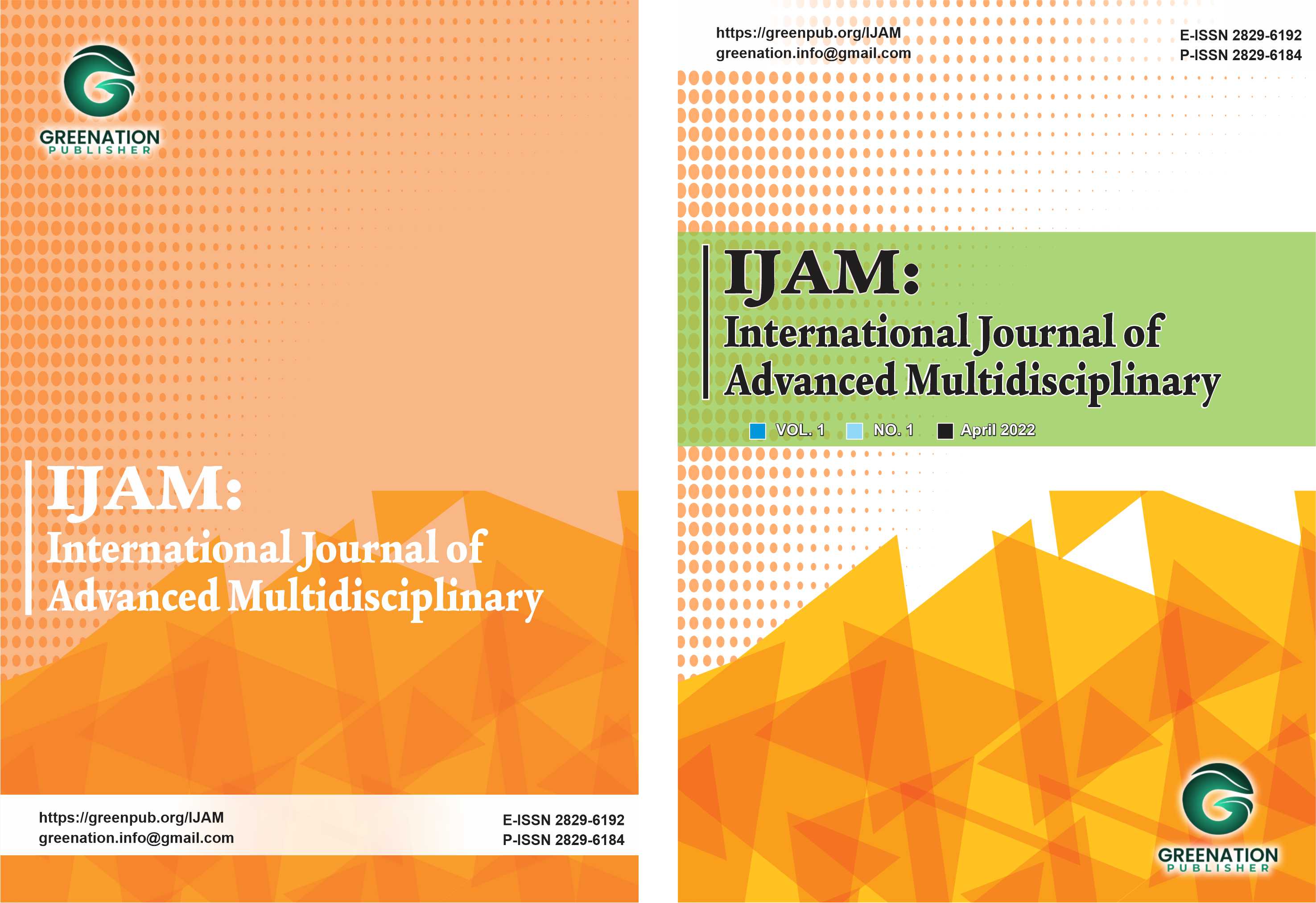Eco Friendly HRM: A Catalyst for Environmental Excellence in Hospitality
DOI:
https://doi.org/10.38035/ijam.v2i3.351Keywords:
HRM, GRHM, HospitalityAbstract
This article looks at components of human resource management (GRHM) practices to promote greater environmental performance with the goal of providing empirical proof that green HRM adoption is a key contributor to environmental performance in the hospitality industry. As a result, the part that follows summarizes the research findings and examines the literature review on GRHM practices, environmental performance, and underlying ideas. The researcher presents the research''s methodologies, findings, analysis, and conclusion in the next part.This research strategy combines literary (document) study with a qualitative methodology. The majority of local and international textbooks, papers, periodicals, sessions, websites, and electronic information, rules, laws, and regulations were employed by researchers to gather the data for this study. Google Schoolar was used to do journal searches. based on the search results discovered and choosing information that satisfies the requirements. The researcher used a systematic literature review technique to analyze the data, which entails selecting, analyzing, and interpreting a variety of data pertinent to the research topic in order to meet the study''s goals (Kitchenham and Charters, 2007).The results of numerous research demonstrate the considerable and favorable benefits of green human resource management strategies on environmental performance. Green recruitment, green training, and green awards are examples of environmentally friendly human resource management strategies that can boost an organization''s environmental performance and provide it a competitive edge Environmental protection or creating opportunities for employees to participate in ecological consultation and problem-solving groups and actively communicate with hotel industry leaders regarding environmental activities. Green performance appraisal plays an important role in achieving environmental performance as this practice provides a strategy for evaluating employee performance against environment-related standards and includes unrelated factors regarding green progress in performance feedback discussions. Environmental performance appraisal is a process through which employees are encouraged to improve their professional skills in environmental issues, thereby helping to better achieve environmental performance goals and objectives.
References
Alfes, K., Shantz, A. D., Truss, C., & Soane,
E. C. (2013). The Link Between Perceived Human Resource Management Practices, Engagement And Employee Behaviour: A Moderated Mediation Model. The International Journal of Human Resource Management, 24(2), 330– 351.
Arulrajah, A. A., Opatha, H., & Nawaratne,
N. N. J. (2015). Green Human Resource Management Practices: A Review. Sri Lankan Journal of Human Resource Management, 5(1).
Bangwal, D., & Tiwari, P. (2015). Green HRM--A Way To Greening The Environment. IOSR Journal of Business and Management, 17(12), 45–53.
Berber, N., & Aleksi?, M. (2016). Green Human Resource Management: Organizational Readiness For Sustainability. International Scientific Conference the Priority Directions of National Economy Development, Faculty of Economics, University of Niš, 271–282.
Bhutto, S. A., & Auranzeb. (2016). Effects Of Green Human Resources Management On Firm Performance: An Empirical Study On Pakistani Firms. European Journal of Business and Management, 8(16), 119–125.
Chaklader, B., & Gulati, P. A. (2015). A Study Of Corporate Environmental Disclosure Practices Of Companies Doing Business In India. Global Business Review, 16(2), 321–335.
Cherian, J., & Jacob, J. (2012). A Study Of Green HR Practices And Its Effective Implementation In The Organization: A review.
Daily, B. F., Bishop, J. W., & Govindarajulu,
N. (2009). A Conceptual Model For Organizational Citizenship Behavior Directed Toward The Environment. Business & Society, 48(2), 243–256.
Daily, B. F., Bishop, J. W., & Massoud, J. A. (2012). The Role Of Training And Empowerment In Environmental Performance. International Journal of Operations & Production Management.
Daily, B. F., Bishop, J. W., & Steiner, R. (2007). The Mediating Role Of EMS Teamwork As It Pertains To HR Factors And Perceived Environmental Performance. Journal of Applied Business Research (JABR), 23(1).
Deepika, R., & Karpagam, V. (2016). A Study On Green HRM Practices In An Organisation. International Journal of Applied Research, 2(8), 426–429.
Deshwal, P. (2015). Green HRM: An Organizational Strategy Of Greening People. International Journal of Applied Research, 1(13), 176–181.
DiPietro, R. B., Cao, Y., & Partlow, C. (2013). Green Practices In Upscale Foodservice Operations. International Journal of Contemporary Hospitality Management.
Dutta, S. (2012). Greening people: A Strategic Dimension. ZENITH International Journal of Business Economics & Management Research, 2(2).
Gholami, H., Rezaei, G., Saman, M. Z. M., Sharif, S., & Zakuan, N. (2016). State- of-the-art Green HRM System: Sustainability In The Sports Center In Malaysia Using A Multi-Methods Approach And Opportunities For Future Research. Journal of Cleaner Production, 124, 142–163.
Ghosh, S., & Mukherjee, S. (2006). Measurement of corporate performance through Balanced Scorecard: an overview.
Guerci, M., Longoni, A., & Luzzini, D. (2016). Translating Stakeholder Pressures Into Environmental Performance--The Mediating Role Of Green HRM Practices. The International Journal of Human Resource Management, 27(2), 262–289.
Guerci, M., Montanari, F., Scapolan, A., & Epifanio, A. (2016). Green And Nongreen Recruitment Practices For Attracting Job Applicants: Exploring Independent And Interactive Effects. The International Journal of Human Resource Management, 27(2), 129–150.
Harvey, D. M., Bosco, S. M., & Emanuele,G. (2010). The Impact Of Green-Collar Workers On Organizations. Management Research Review.
Jabbar, M. H., & Abid, M. (2014). GHRM:
Motivating Employees Towards Organizational Environmental Performance. MAGNT Research Report, 2(4), 267–278.
Jabbour, Charbel Jose Chiappetta. (2011). How Green Are HRM Practices, Organizational Culture, Learning And Teamwork? A Brazilian Study. Industrial and Commercial Training.
Jabbour, Charbel José Chiappetta. (2013). Environmental Training In Organisations: From A Literature Review To A Framework For Future Research. Resources, Conservation and Recycling, 74, 144–155.
Jabbour, Charbel José Chiappetta, & de Sousa Jabbour, A. B. L. (2016). Green Human Resource Management And Green Supply Chain Management: Linking two emerging agendas. Journal of Cleaner Production, 112, 1824–1833.
Jabbour, Charbel José Chiappetta, Santos, F.C. A., & Nagano, M. S. (2008). Environmental Management System And Human Resource Practices: Is There A Link Between Them In Four Brazilian Companies? Journal of Cleaner Production, 16(17 1922– 1925.
Jabbour, Charbel José Chiappetta, Santos, F. C. A., & Nagano, M. S. (2010). Contributions of HRM Throughout The Stages Of Environmental Management: Methodological Triangulation Applied To Companies In Brazil. The International Journal of Human Resource Management, 21(7), 1049– 1089.
Jackson, S. E., Renwick, D. W. S., Jabbour, C. J. C., & Muller-Camen, M. (2011). State-of-the-Art and Future Directions for Green Human Resource Management: Introduction To The Special Issue. German Journal of Human Resource Management: Zeitschrift Für Personalforschung, 25(2), 99–116.
Jackson, Susan E, & Seo, J. (2010). The Greening Of Strategic HRM Scholarship. Organization Management Journal, 7(4), 278–290.
Kaithal, H.--I. (2017). Concept of Green HRM in Banking Industry. International Journal, 5(7).
Kang, K. H., Lee, S., & Huh, C. (2010). Impacts Of Positive And Negative Corporate Social Responsibility Activities On Company Performance In The Hospitality Industry. International Journal of Hospitality Management, 29(1), 72–82.
Kapil, P. (2015). Green HRM-Engaging Human Resource In Reducing Carbon Footprint And Enhancing Environment Sustainability: A Case Study Based Approach. International Journal of Engineering Technology Science and Research, 2(5), 14.
Kitchenham, B., & Charters, S. (2007). Guidelines For Performing Systematic Literature Reviews In Software Engineering.
Liebowitz, J. (2010). The role of HR in Achieving A Sustainability Culture. Journal of Sustainable Development, 3(4), 50–57.
Lo, S. H., Peters, G.-J. Y., & Kok, G. (2012).
A Review Of Determinants Of And Interventions For Proenvironmental Behaviors In Organizations. Journal of Applied Social Psychology, 42(12), 2933–2967.
Lober, D. J. (1996). Evaluating The Environmental Performance Of Corporations. Journal of Managerial Issues, 184–205.
Mampra, M. (2013). Green HRM: Does It Help To Build A Competitive Service Sector? A study. Proceedings of Tenth AIMS International Conference on Management, 1273–1281.
Mandip, G. (2012). Green HRM: People Management Commitment To Environmental Sustainability. Research Journal of Recent Sciences, ISSN, 2277, 2502.
Masri, H. A., & Jaaron, A. A. M. (2017). Assessing Green Human Resources Management Practices In Palestinian Manufacturing Context: An Empirical Study. Journal of Cleaner Production, 143, 474–489.
Mathis, R. L., & Jackson, J. H. (2011). Human Resource Management: Essential Perspectives. Cengage Learning.
Mehta, K., & Chugan, P. K. (2015). Green HRM In Pursuit Of Environmentally Sustainable Business. Pursuit of Environmentally Sustainable Business (June 1, 2015). Universal Journal of Industrial and Business Management, 3(3), 74–81.
Melnyk, S. A., Sroufe, R. P., & Calantone, R. (2003). Assessing The Impact Of Environmental Management Systems On Corporate And Environmental Performance. Journal of Operations Management, 21(3), 329–351.
Mensah, I. (2006). Environmental Management Practices Among Hotels In The Greater Accra Region. International Journal of Hospitality Management, 25(3), 414–431.
Milliman, J., & Clair, J. (2017). Best Environmental HRM Practices In The US. In Greening People (pp. 49–73). Routledge.
Mittal, V. K., & Sangwan, K. S. (2014). Prioritizing Drivers For Green Manufacturing: Environmental, Social And Economic Perspectives. Procedia CIRP, 15, 135–140.
Molina-Azorin, J. F., Tari, J. J., Pereira- Moliner, J., Lopez-Gamero, M. D., & Pertusa-Ortega, E. M. (2015). The Effects Of Quality And Environmental Management On Competitive Advantage: A Mixed Methods Study In The Hotel Industry. Tourism Management, 50,
Opatha, H. (2013). Green Human Resource Management A Simplified Introduction.
Opatha, H. H. D. N. P., & Arulrajah, A. A. (2014). Green Human Resource Management: Simplified General Reflections. International Business Research, 7(8), 101.
Owino, W. A., & Kwasira, J. (2016). Influence Of Selected Green Human Resource Management Practices On Environmental Sustainability At
Menengai Oil Refinery Limited Nakuru, Kenya. J. Hum. Resour. Manag, 4, 19–27.
Paillé, P., Boiral, O., & Chen, Y. (2013). Linking Environmental Management Practices And Organizational Citizenship Behaviour For The Environment: A Social Exchange Perspective. The International Journal of Human Resource Management, 24(18), 3552–3575.
Pandey, S., Viswanathan, V., & Kamboj, P. (2016). Sustainable Green HRM-- Importance And Factors Affecting Successful Implementation In Organizations. International Journal of Research in Management and Business, 2(3), 11–29.
Pillai, R., & Sivathanu, B. (2014). Green Human Resource Management. Zenith International Journal of Multidisciplinary Research, 4(1), 72– 82.
Ployhart, R. E. (2012). The Psychology Of Competitive Advantage: An Adjacent Possibility. Industrial and Organizational Psychology, 5(1), 62– 81.
Prasad, R. (2013). Green HRM-Partner in Sustainable Competitive Growth. Journal of Management Sciences and Technology, 1(1), 15–18.
Prathima, M., & Misra, S. (2012). The Green Revolution In Human Resource Management. Asia Pacific Journal of Management & Entrepreneurship Research, 1(3), 227.
Rawashdeh, A. M., & karim Al-Adwan, I. (2012). The Impact Of Human Resource Management Practices On Corporate Performance: Empirical Study In Jordanian Commercial Banks. African Journal of Business Management, 6(41), 10591.
Razab, M. F., Udin, Z. M., & Osman, W. N. (2015). Understanding The Role Of GHRM Towards Environmental Performance. Journal of Global Business and Social Entrepreneurship (GBSE), 1(2), 118–125.
Renwick, D. W. S., Redman, T., & Maguire, S. (2013). Green Human Resource Management: A Review And Research Agenda. International Journal of Management Reviews, 15(1), 1–14.
Ridhi Sharma, N. G. (2015). Green HRM: An Innovative Approach to Environmental Sustainability. 12th AIMS International Conference on Management, 1–15.
Rodriguez-Antón, J. M., del Mar Alonso- Almeida, M., Celemin, M. S., & Rubio, L. (2012). Use Of Different Sustainability Management Systems In The Hospitality Industry. The case of Spanish hotels. Journal of Cleaner Production, 22(1), 76–84.
Roy, M., & Khastagir, D. (2016). Exploring Role Of Green Management In Enhancing Organizational Efficiency In Petro-Chemical Industry In India. Journal of Cleaner Production, 121, 109–115.
Sathyapriya, J., Kanimozhi, R., & Adhilakshmi, V. (2013). Green HRM- Delivering High Performance HR Systems. International Journal of Marketing and Human Resource Management, 4(2), 19–25.
Schuler, R., & Jackson, S. E. (2014). Human Resource Management And Organizational Effectiveness: Yesterday And Today. Journal of Organizational Effectiveness: People and Performance.
Downloads
Published
How to Cite
Issue
Section
License
Authors who publish their manuscripts in this journal agree to the following conditions:
- The copyright on each article belongs to the author(s).
- The author acknowledges that the International Journal of Advanced Multidisciplinary (IJAM) has the right to be the first to publish with a Creative Commons Attribution 4.0 International license (Attribution 4.0 International (CC BY 4.0).
- Authors can submit articles separately, arrange for the non-exclusive distribution of manuscripts that have been published in this journal into other versions (e.g., sent to the author's institutional repository, publication into books, etc.), by acknowledging that the manuscript has been published for the first time in the International Journal of Advanced Multidisciplinary (IJAM).























